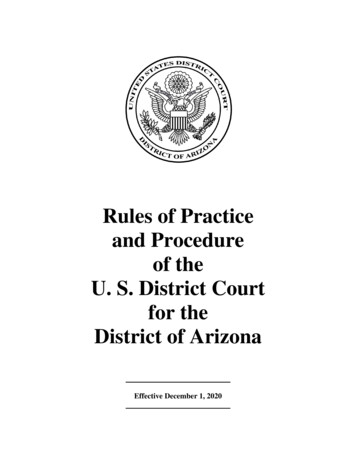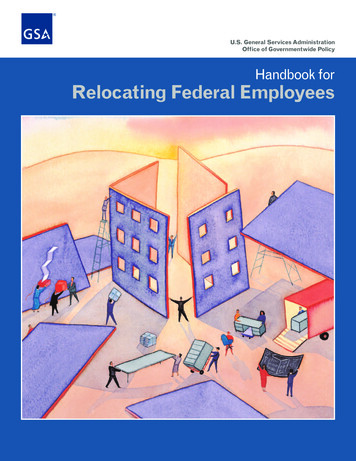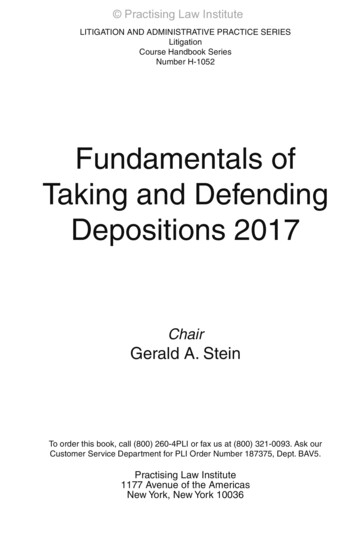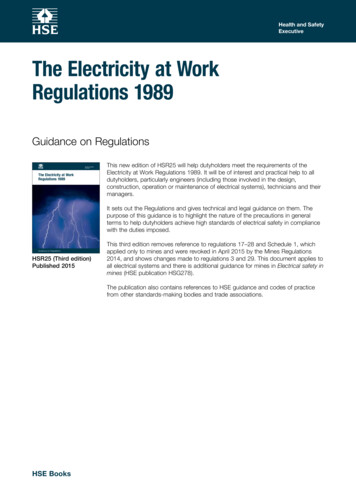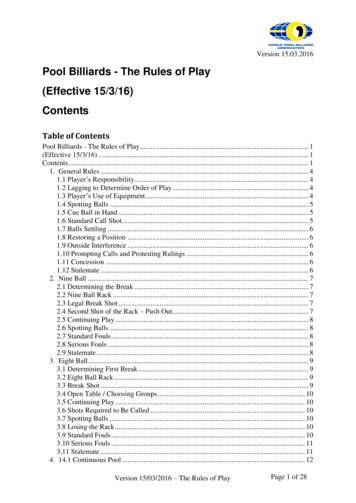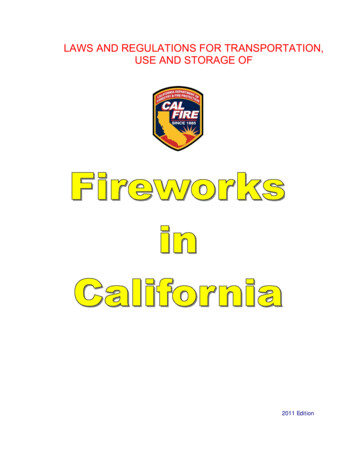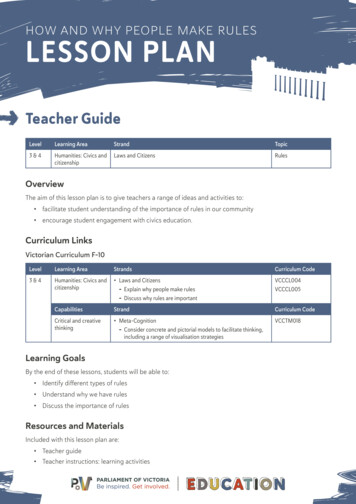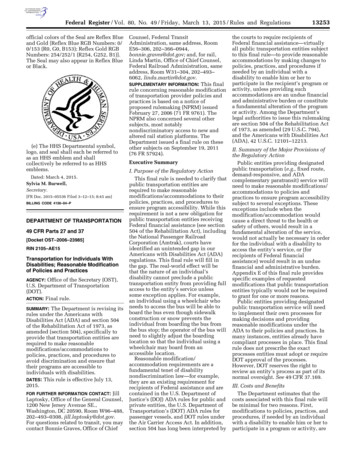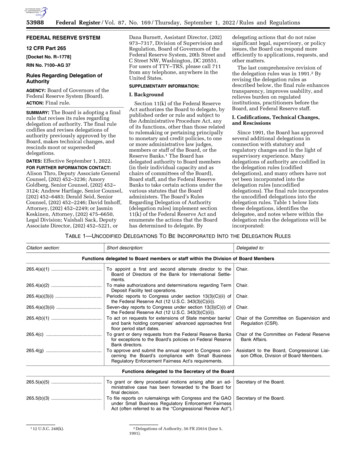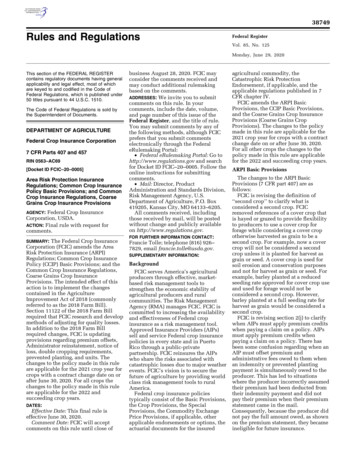
Transcription
38749Rules and RegulationsFederal RegisterVol. 85, No. 125Monday, June 29, 2020This section of the FEDERAL REGISTERcontains regulatory documents having generalapplicability and legal effect, most of whichare keyed to and codified in the Code ofFederal Regulations, which is published under50 titles pursuant to 44 U.S.C. 1510.The Code of Federal Regulations is sold bythe Superintendent of Documents.DEPARTMENT OF AGRICULTUREFederal Crop Insurance Corporation7 CFR Parts 407 and 457RIN 0563–AC69[Docket ID FCIC–20–0005]Area Risk Protection InsuranceRegulations; Common Crop InsurancePolicy Basic Provisions; and CommonCrop Insurance Regulations, CoarseGrains Crop Insurance ProvisionsFederal Crop InsuranceCorporation, USDA.ACTION: Final rule with request forcomments.AGENCY:The Federal Crop InsuranceCorporation (FCIC) amends the AreaRisk Protection Insurance (ARPI)Regulations; Common Crop InsurancePolicy (CCIP) Basic Provisions; and theCommon Crop Insurance Regulations,Coarse Grains Crop InsuranceProvisions. The intended effect of thisaction is to implement the changescontained in the AgricultureImprovement Act of 2018 (commonlyreferred to as the 2018 Farm Bill).Section 11122 of the 2018 Farm Billrequired that FCIC research and developmethods of adjusting for quality losses.In addition to the 2018 Farm Billrequired changes, FCIC is updatingprovisions regarding premium offsets,Administrator reinstatement, notice ofloss, double cropping requirements,prevented planting, and units. Thechanges to the policy made in this ruleare applicable for the 2021 crop year forcrops with a contract change date on orafter June 30, 2020. For all crops thechanges to the policy made in this ruleare applicable for the 2022 andsucceeding crop years.DATES:Effective Date: This final rule iseffective June 30, 2020.Comment Date: FCIC will acceptcomments on this rule until close ofjbell on DSKJLSW7X2PROD with RULESSUMMARY:VerDate Sep 11 201417:30 Jun 26, 2020Jkt 250001business August 28, 2020. FCIC mayconsider the comments received andmay conduct additional rulemakingbased on the comments.ADDRESSES: We invite you to submitcomments on this rule. In yourcomments, include the date, volume,and page number of this issue of theFederal Register, and the title of rule.You may submit comments by any ofthe following methods, although FCICprefers that you submit commentselectronically through the FederaleRulemaking Portal: Federal eRulemaking Portal: Go tohttp://www.regulations.gov and searchfor Docket ID FCIC–20–0005. Follow theonline instructions for submittingcomments. Mail: Director, ProductAdministration and Standards Division,Risk Management Agency, U.S.Department of Agriculture, P.O. Box419205, Kansas City, MO 64133–6205.All comments received, includingthose received by mail, will be postedwithout change and publicly availableon http://www.regulations.gov.FOR FURTHER INFORMATION CONTACT:Francie Tolle; telephone (816) 926–7829, email francie.tolle@usda.gov.SUPPLEMENTARY INFORMATION:BackgroundFCIC serves America’s agriculturalproducers through effective, marketbased risk management tools tostrengthen the economic stability ofagricultural producers and ruralcommunities. The Risk ManagementAgency (RMA) manages FCIC. FCIC iscommitted to increasing the availabilityand effectiveness of Federal cropinsurance as a risk management tool.Approved Insurance Providers (AIPs)sell and service Federal crop insurancepolicies in every state and in PuertoRico through a public-privatepartnership. FCIC reinsures the AIPswho share the risks associated withcatastrophic losses due to major weatherevents. FCIC’s vision is to secure thefuture of agriculture by providing worldclass risk management tools to ruralAmerica.Federal crop insurance policiestypically consist of the Basic Provisions,the Crop Provisions, the SpecialProvisions, the Commodity ExchangePrice Provisions, if applicable, otherapplicable endorsements or options, theactuarial documents for the insuredPO 00000Frm 00001Fmt 4700Sfmt 4700agricultural commodity, theCatastrophic Risk ProtectionEndorsement, if applicable, and theapplicable regulations published in 7CFR chapter IV.FCIC amends the ARPI BasicProvisions, the CCIP Basic Provisions,and the Coarse Grains Crop InsuranceProvisions (Coarse Grains CropProvisions). The changes to the policymade in this rule are applicable for the2021 crop year for crops with a contractchange date on or after June 30, 2020.For all other crops the changes to thepolicy made in this rule are applicablefor the 2022 and succeeding crop years.ARPI Basic ProvisionsThe changes to the ARPI BasicProvisions (7 CFR part 407) are asfollows:FCIC is revising the definition of‘‘second crop’’ to clarify what isconsidered a second crop. FCICremoved references of a cover crop thatis hayed or grazed to provide flexibilityto producers to use a cover crop forforage while considering a cover cropotherwise harvested as grain to be asecond crop. For example, now a covercrop will not be considered a secondcrop unless it is planted for harvest asgrain or seed. A cover crop is used forsoil erosion and conservation purposesand not for harvest as grain or seed. Forexample, barley planted at a reducedseeding rate approved for cover crop useand used for forage would not beconsidered a second crop. However,barley planted at a full seeding rate forharvest as grain would be considered asecond crop.FCIC is revising section 2(j) to clarifywhen AIPs must apply premium creditswhen paying a claim on a policy. AIPsmust apply premium credits whenpaying a claim on a policy. There hasbeen some confusion regarding when anAIP must offset premium andadministrative fees owed to them whenan indemnity or prevented plantingpayment is simultaneously owed to theproducer. This has led to situationswhere the producer incorrectly assumedtheir premium had been deducted fromtheir indemnity payment and did notpay their premium when their premiumstatement came in the mail.Consequently, because the producer didnot pay the full amount owed, as shownon the premium statement, they becameineligible for future insurance.E:\FR\FM\29JNR1.SGM29JNR1
jbell on DSKJLSW7X2PROD with RULES38750Federal Register / Vol. 85, No. 125 / Monday, June 29, 2020 / Rules and RegulationsThere has also been confusion onwhether the AIP is required to apply anoffset for any other crop policy insuredwith the AIP and whether the losspayment was being issued before orafter the premium billing date.Producers may have multiple policieswith an AIP (policies are issued on acrop and county basis), and each policymay have its own premium billing date.FCIC is revising this section to clarifyfor a crop policy with an indemnity due,the producer’s premium andadministrative fees for that same croppolicy will be offset from any indemnityor prevented planting payment due tothe producer even if it is prior to thepremium billing date (will be appliedautomatically). For any other croppolicy insured with the AIP, if the claimis to be paid:(1) Prior to the premium billing date,and the producer agrees, their premiumand administrative fees will be offsetfrom any indemnity or preventedplanting payment due them (will not beapplied automatically); or(2) On or after the premium billingdate, the producer’s premium andadministrative fees will be offset fromany indemnity or prevented plantingpayment due to the producer (will beapplied automatically).For example, a producer in AllenCounty, Kansas, insures both winterwheat and corn. Winter wheat has apremium billing date of July 1 and cornhas a premium billing date of August15. The producer was prevented fromplanting corn in April. The AIP musttake the amount owed for premium andadministrative fees for corn from theprevented planting payment. Because itis before the premium billing date forwinter wheat, the AIP may take theamount owed for premium andadministrative fees for winter wheatwith the producer’s consent.FCIC is revising section 2(k)(2)(iii)and adding new section2(k)(2)(iii)(C)(1)(iv) to broaden theauthority given to the RMA’sAdministrator to reinstate producersthat inadvertently failed to pay a debttimely. In addition, FCIC is authorizingthe AIPs to allow reinstatement up to 15calendar days after a due date forpayment received during a previouslyexecuted payment agreement. Thisincludes clarifying that in order to bereinstated, when a producer has apreviously executed a written paymentagreement to pay a debt, they arerequired to pay the amount duespecified in the payment agreement,rather than the full amount owed. Theremaining portion of the paymentagreement is not yet due.VerDate Sep 11 201417:30 Jun 26, 2020Jkt 250001FCIC is adding a new section 13(c)(5)to allow the allocation of comingled firstand second crop production to theassociated crop acreage in proportion tothe liability for the acreage that was andwas not double cropped. Producers hadfound challenges keeping separaterecords of acreage and production thatwas and was not double croppedbecause often the acreage is in the verysame field and they harvest both firstand second crop production at the sametime. For example, a producer has twofields in the same unit which are nextto each other (contiguous). On one fieldthey plant wheat, harvest the wheat, andthen plant double crop soybeans. Theother field was a single crop of soybeansonly. The producer may harvest bothsoybean fields at the same time makingit difficult to keep the productionseparate. This provision is currentlycontained in the CCIP Basic Provisionsand it is also appropriate in the ARPIBasic Provisions.FCIC is adding a new section 13(c)(6)to address double croppingrequirements when another plan ofinsurance does not require records ofproduction. FCIC is adding a newparagraph to state that each insuredcrop must follow its own BasicProvisions, Crop Provisions, and SpecialProvisions to determine if the doublecropping requirements have been met. Ifthe double cropping requirements in theapplicable Basic Provisions, CropProvisions, or Special Provisions havenot been met for each insured crop, theBasic Provisions for that crop policyapply regarding payment reductionswhen the double cropping requirementsare not met. For example, a producermay have both a policy under theRainfall and Vegetation Index plan ofinsurance (RIVI provisions) and CCIPBasic Provisions. If a crop insured underthe Annual Forage Crop Provisions (aninsurance policy that uses the RIVIprovisions) is involved in a scenariowhere the AIP is determining if theacreage meets the double croppingrequirements or if the first crop andsecond crop rules apply, the AnnualForage Crop Provisions and RIVIprovisions should be followed not theCCIP Basic Provisions.FCIC is revising section 13(d) toexplain how to determine a producer’sdouble cropping acreage eligibility. Toqualify for double cropping, a producermust have records that show the acreagewas double cropped in at least 2 of thelast 4 crop years in which the firstinsured crop was grown or have recordsthat show the applicable acreage meetsthis requirement. The producer’s doublecropping acreage eligibility is thenlimited to the highest number of acresPO 00000Frm 00002Fmt 4700Sfmt 4700double cropped within the applicable 4year period.FCIC is also adding a new section13(d)(3) to allow eligible doublecropping acres to be based on either:(1) The greatest number of acresdouble cropped in 2 of the last 4 cropyears in which the first insured cropwas grown; or(2) The percentage of acreshistorically double cropped in 2 of thelast 4 crop years in which the firstinsured crop was grown.For example, if a producer has a 100acre farm and has historically doublecropped 50 acres planted to wheatfollowed by soybeans (50 percent ofacres historically double cropped), andthe producer purchases and plants anadditional 200 acres of wheat for a totalof 300 acres of planted wheat, thenumber of acres eligible for doublecropping would be based on 50 percent,or 150 acres. If the producer hashistorically double cropped wheatfollowed by soybeans on some or evenall of the acreage, there is a reasonablepresumption they may continue to do soin the future. This change is currentlycontained in the CCIP Basic Provisionsand it is appropriate in the ARPI BasicProvisions.CCIP Basic ProvisionsThe changes to the CCIP BasicProvisions (7 CFR part 457.8) are asfollows:FCIC is revising the definition of‘‘basic unit’’ to clarify and exclude aportion of the crop in the county acreagethat was reported as an enterprise unit.A basic unit is all insurable acreage ofthe insured crop in the county on thedate coverage begins for the crop year inwhich the insured has 100 percent cropshare, or which is owned by one personand operated by another person on ashare basis. For example, if an insuredowns land and rents land from twolandlords on a share basis, they wouldhave three basic units for the insuredcrop in the county. FCIC is revising thedefinition to clarify and exclude aportion of the crop in the county acreagethat was reported as an enterprise unit.As written, the definition of the basicunit includes all insurable acreage of thecrop in the county; however, some ofthe acreage can be reported as anenterprise unit, which has a separatedefinition. Therefore, FCIC is updatingthe definition of ‘‘basic unit’’ tocorrectly reflect the acreage interactionswith enterprise units and optional units.An enterprise unit is all insurableacreage of a crop or all insurableirrigated or non-irrigated acreage of thecrop in the county in which the insuredhas a share. An enterprise unit can beE:\FR\FM\29JNR1.SGM29JNR1
jbell on DSKJLSW7X2PROD with RULESFederal Register / Vol. 85, No. 125 / Monday, June 29, 2020 / Rules and Regulationscomprised of multiple basic units. Anoptional unit is a subdivision of a basicunit. A basic unit can be comprised ofmultiple optional units.FCIC is revising the definition of‘‘second crop’’ to clarify what isconsidered a second crop. FCICremoved references of a cover crop thatis hayed or grazed to provide flexibilityto producers to utilize a cover crop forforage while considering a cover cropotherwise harvested as grain to be asecond crop. For example, now a covercrop will not be considered a secondcrop unless it is planted for harvest asgrain or seed. For example, barleyplanted at a reduced seeding rateapproved for cover crop use and usedfor forage would not be considered asecond crop. However, barley planted ata full seeding rate for harvest as grainwould be considered a second crop.FCIC is adding corresponding changesto section 15(g)(3) of the BasicProvisions to allow silage, haylage, andbaleage to be treated the same as hayingand grazing in regard to cover andvolunteer crops when it comes topayment reductions when a crop isprevented from being planted and avolunteer crop or cover crop is hayed,or grazed, or cut for silage, haylage, orbaleage from the same acreage duringthe crop year.FCIC is revising the definition of‘‘veteran farmer or rancher’’ byreplacing the word ‘‘and’’ with ‘‘or’’after the phrase, ‘‘Air Force,’’. FCIC isalso revising the definition to usesemicolons to separate the items of thelist in this definition because one of theitems in the list contains commas anda semicolon will avoid potentialconfusion.FCIC is revising section 2(e) to clarifywhen AIPs must apply premium creditswhen paying a claim on a policy. AIPsmust apply premium credits whenpaying a claim on a policy. There hasbeen some confusion regarding when anAIP must offset premium andadministrative fees owed to them whenan indemnity or prevented plantingpayment is simultaneously owed to theproducer. This has led to situationswhere the producer incorrectly assumedtheir premium had been deducted fromtheir indemnity payment and did notpay their premium when their premiumstatement came in the mail.Consequently, because the producer didnot pay the full amount owed, as shownon the premium statement, they becameineligible for future insurance.There has also been confusion onwhether the AIP is required to apply anoffset for any other crop policy insuredwith the AIP and whether the losspayment was being issued before orVerDate Sep 11 201417:30 Jun 26, 2020Jkt 250001after the premium billing date.Producers may have multiple policieswith an AIP (policies are issued on acrop and county basis), and each policymay have its own premium billing date.FCIC is revising this section to clarifyfor a crop policy with an indemnity due,the producer’s premium andadministrative fees for that same croppolicy will be offset from any indemnityor prevented planting payment due tothe producer even if it is prior to thepremium billing date (will be appliedautomatically). For any other croppolicy insured with the AIP, if the claimis to be paid:(1) Prior to the premium billing date,and the producer agrees, their premiumand administrative fees will be offsetfrom any indemnity or preventedplanting payment due them (will not beapplied automatically); or(2) On or after the premium billingdate, the producer’s premium andadministrative fees will be offset fromany indemnity or prevented plantingpayment due to the producer (will beapplied automatically).For example, a producer in AllenCounty, Kansas insures both winterwheat and corn. Winter wheat has apremium billing date of July 1 and cornhas a premium billing date of August15. The producer was prevented fromplanting corn in April. The AIP musttake the amount owed for premium andadministrative fees for corn from theprevented planting payment. Because itis before the premium billing date forwinter wheat, the AIP may take theamount owed for premium andadministrative fees for winter wheatwith the producer’s consent.FCIC is revising section 2(f)(2)(iii) andadding new section 2(f)(2)(iii)(C)(1)(iv)to broaden the authority given to theRMA’s Administrator to reinstateproducers that inadvertently failed topay a debt timely. In addition, FCIC isauthorizing the AIPs to allowreinstatement up to 15 calendar daysafter a due date for payment receivedduring a previously executed paymentagreement. This includes clarifying thatin order to be reinstated, when aproducer has a previously executedwritten payment agreement to pay adebt, they are required to pay theamount due specified in the paymentagreement, rather than the full amountowed. The remaining portion of thepayment agreement is not yet due.FCIC is revising section 4(c) andadding paragraph (d). Changes tosection 4 were made in the CatastrophicRisk Protection Endorsement; Area RiskProtection Insurance Regulations; andCommon Crop Insurance Policy BasicProvisions Final rule with request forPO 00000Frm 00003Fmt 4700Sfmt 470038751comments, published in the FederalRegister on June 28, 2019 (84 FR 30857).The change made in that rule providedthat AIPs will send the changeselectronically, unless the policyholderrequested a hard copy. The changesdescribed in that rule were not made inthe Code of Federal Regulations. Thisrule is making the required technicalcorrections to make that change now.FCIC is revising section 14(b)(5) toclarify a notice of loss must be filed, bythe producer, for an AIP to considerwhether the delayed notice impactstheir ability to adjust losses as providedby section 14(b)(5). This was inresponse to agents filing a blanket noticeof loss on behalf of producers andproducers not being aware a loss wasfiled on their behalf. For example,starting in 2016, 85 percent of burleytobacco claims were filed on July 1 andlisted that date of damage. These claimswere being filed on the first of themonth with anticipation of a loss later.Large claims were investigated by RMAand discussed with the producer that atthe time, the producer did not expect aloss.FCIC is revising section 15(g)(3)(i) tostate the reduction in preventedplanting payment will apply if avolunteer crop or cover crop is hayed,grazed, or cut for silage, haylage, orbaleage from the same acreage, after thelate planting period (or after the finalplanting date if a late planting period isnot applicable) for the first insured cropin the same crop year. Prior to this finalrule, the provisions in the regulation didnot treat cutting a volunteer crop orcover crop for silage, haylage, or baleagethe same as it does for haying andgrazing. This change will allow silage,haylage, and baleage to be treated thesame as haying and grazing regardingcover and volunteer crops.FCIC is removing the provisions fromsection 15(h)(5)(i) and moving theprovisions to a new section 15(i)(3). Theprovisions provide instructions todetermine the amount of historicaldouble cropping acres that are availableto use for insurance in the current cropyear.FCIC is adding a new section 15(h)(7)to address double croppingrequirements when another plan ofinsurance does not require records ofproduction. FCIC is adding a newsection to provide that each insuredcrop must follow its own BasicProvisions, Crop Provisions, and SpecialProvisions to determine if the doublecropping requirements have been met. Ifthe double cropping requirements in theapplicable Basic Provisions, CropProvisions, or Special Provisions havenot been met for each insured crop, theE:\FR\FM\29JNR1.SGM29JNR1
jbell on DSKJLSW7X2PROD with RULES38752Federal Register / Vol. 85, No. 125 / Monday, June 29, 2020 / Rules and RegulationsBasic Provisions for that crop policyapply regarding payment reductionswhen the double croppingrequirements. For example, a producermay have both a policy under the RIVIprovisions and CCIP Basic Provisions. Ifthe Annual Forage Crop Provisions (aninsurance policy that uses the RIVIprovisions) is one of the crops involvedin a scenario where the AIP isdetermining if the acreage meets thedouble cropping requirements or if thefirst crop and second crop rules apply,the Annual Forage Crop Provisions andRIVI provisions should be followed notthe CCIP Basic Provisions.FCIC is revising the language in 15(i)to explain how to determine aproducer’s double cropping acreageeligibility. To qualify for doublecropping a producer must have recordsthat show the acreage was doublecropped in at least 2 of the last 4 cropyears in which the first insured cropwas grown or have records that showthe applicable acreage meets thisrequirement. The producer’s doublecropping acreage eligibility is thenlimited to the highest number of acresdouble cropped within the applicable 4year period.FCIC is adding a new section17(e)(1)(iii)(C) to clarify how eligibleacres are determined for crops thatrequire a processor contract to beinsured. FCIC has been asked to addresssituations where some producers hadreduced contracted acreage, which wasnot reduced solely due to preventedplanting, or have no contracted acres forthe current crop year. Some producersin this reduced or no contracted acresscenario have exhausted all eligibleprevented planting acreage and are noteligible to provide prevented plantingcoverage to remaining cropland acres.Therefore, FCIC is adding new section17(e)(iii)(C) to allow a producer who hasexhausted eligible acres to provideprevented planting coverage for allinsured cropland acres in the farmingoperation due to a reduced contract inthe current crop year, to use theprevious crop year’s contract for theremaining acres. This is to incorporatechanges issued under Manager’sBulletin: MGR–19–029 (PreventedPlanting Eligible Acre History whenContracted Crop Acres are Reduced),published on RMA’s website onDecember 23, 2019. FCIC has also addeda reference to the new section17(e)(1)(iii)(C) in section 17(h)(4).For example, a producer has alwaysgrown 1,000 acres of contracted sugarbeets, 1,000 acres of soybeans, and 1,000acres of corn. For the 2020 crop year,the producer’s sugar beet contract wasreduced to 500 acres. The producer stillVerDate Sep 11 201417:30 Jun 26, 2020Jkt 250001has 3,000 cropland acres available toplant. Therefore, the producer plans toplant 500 acres of sugar beets, 1,250acres of soybeans, and 1,250 acres ofcorn. With a wet spring, the producer isonly able to plant 1,000 acres of corn,1,000 acres of soybeans, and 500 acresof contracted sugar beets. Under theprovisions prior to this regulation, theproducer would not have qualified forprevented planting on the remaining500 acres in the farming operation(despite that they have planted andinsured 3,000 cropland acres in the past5 years) because section 17(e)(1)(iii)stated that the number of eligible acresfor any crop that must be contractedwith a processor to be insured will bethe number of acres specified in theprocessor contract. However, under theprovisions prior to this rule, if there wasno contract in place, the producer coulduse their history of the contracted crop.Under the revised provisions, if theproducer has exhausted eligible acres toprovide prevented planting coverage forall insured cropland acres in thefarming operation due to a reducedcontract in the current crop year, theprevious crop year’s contract may beused for the remaining acres. In thisexample, the producer would be eligiblefor 3,000 acres of prevented plantingpaid in accordance with section 17(h) ofthe CCIP Basic Provisions.FCIC is revising section 17(f)(4)(ii)regarding how to determine a producer’sdouble cropping acreage eligibility.Consistent with section 15(i), to qualifyfor double cropping a producer musthave records that show the acreage wasdouble cropped in at least 2 of the last4 crop years in which the insured cropthat is prevented from being plantedwas grown or have records that showthe applicable acreage meets thisrequirement. The producer’s doublecropping acreage eligibility is thenlimited to the highest number of acresdouble cropped within the applicable 4year period.FCIC is revising section 17(f)(5) torevise prevented planting and covercrops provisions. FCIC is clarifying thathaying or grazing a cover crop will notimpact eligibility for a preventedplanting payment provided such actiondid not contribute to the acreage beingprevented from planting. Thisincorporates allowances from a SpecialProvisions statement and in result, theSpecial Provisions statement isremoved.FCIC is revising section34(a)(4)(viii)(C) to clarify current unitstructure options and add an additionalunit option when enterprise units forboth irrigated and non-irrigatedpractices are elected, but the producerPO 00000Frm 00004Fmt 4700Sfmt 4700doesn’t qualify. If discovery for notqualifying is on or before the acreagereporting date, the producer has anadditional option to elect an enterpriseunit on one practice and a basic oroptional unit on the other practice.Previously, a producer’s options wereeither one enterprise unit containingboth practices or basic or optional unitsfor both practices, whichever theproducer reported on the acreage reportand qualified for.FCIC is adding provisions to section36 to provide another risk managementoption to producers that will allow aproducer to replace post-qualityproduction amounts in the APHdatabases with their pre-qualityproduction amounts, thereforeincreasing their APH database yield forindividual crop years with a Notice ofLoss. This quality loss option’s overallimpact is to prevent an insuredproducer’s guarantee from declining dueto low quality when this option iselected.Section 11122 of the 2018 Farm Billrequired that FCIC research and developmethods of adjusting for quality lossesthat:(1) Do not impact the actualproduction history of a producer;(2) Allow producers to exclude aquality loss from their actual productionhistory when the quality loss isinsufficient to trigger an indemnitypayment;(3) Is optional for a producer to use;and(4) Is offered at an actuarially soundpremium rate.Over the past year, RMA hasconducted research and developmentefforts as required by the 2018 FarmBill, including extensive stakeholderoutreach, for implementing this option.Coarse Grains Crop InsuranceProvisionsThe changes to the Coarse GrainsCrop Insurance Provisions (7 CFR457.113) are:FCIC is revising section 2(c)(1) toreplace the phrase, ‘‘or separateenterprise units for both,’’ with ‘‘orseparate enterprise units for one or bothpractices,’’ to clarify what options forenterprise unit elections are available.As previously written, the intendedmeaning may not have been clear andthe change will make it clear that ifenterprise unit elections are made, anenterprise unit must be elected by bothFAC and NFAC practices, rather thanthe option of electing an enterprise unitfor one practice, and basic or optionalunits on the other practice; or enterpriseunits for both practices.E:\FR\FM\29JNR1.SGM29JNR1
Federal Register / Vol. 85, No. 125 / Monday, June 29, 2020 / Rules and RegulationsFCIC is revising section 2(a)(i)(4) toclarify current unit structure optionsand add an additional unit option whenenterprise units for both FAC(Following Another Crop) and NFAC(Not Following Another Crop) croppingpractices are elected, but the producerdoesn’t qualify. If discovery for notqualifying is on or before the acreagereporting date, the producer has anadditional option to elect an enterpriseunit on one cropping practice and abasic or optional unit on the othercropping practice. Previously, aproducer’s options were either oneenterprise unit containing both croppingpractices or basic or optional units forboth cropping practices, whichever theproducer reported on the acreage reportand qualified for. This is consistent withsimilar changes made to the CCIP BasicProvisions for enterprise units byseparate irrigation practices.jbell on DSKJLSW7X2PROD with RULESMiscellaneous ChangesIn addition to the changes discussedabove, FCIC is making non-substantivechanges in the regulations. Examples ofthese changes include makingreferences consistent, updating thewebsite address, making grammaticalcorrections, and clarifying wordchanges.FCIC is revising references throughoutthe regulations in §§ 407.9 and 457.8 toconsistently refer to ‘‘FCIC procedures.’’FCIC refers to these documentsinconsistently throughout the ARPI andthe CCIP regulations. For example, thesame documents a
AGENCY: Federal Crop Insurance Corporation, USDA. ACTION: Final rule with request for comments. SUMMARY: The Federal Crop Insurance Corporation (FCIC) amends the Area Risk Protection Insurance (ARPI) Regulations; Common Crop Insurance Policy (CCIP) Basic Provisions; and the Common Crop Insurance Regulations, Coarse Grains Crop Insurance Provisions.
